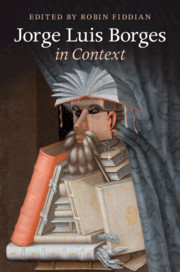Book contents
- Jorge Luis Borges in Context
- Jorge Luis Borges in Context
- Copyright page
- Contents
- Illustrations
- Contributors
- Acknowledgements
- Permissions
- Note on Primary Sources and Editions Used
- Chronology
- Note on Translations and Abbreviations
- Introduction Borges in Context, Context in Borges
- Part I Self, Family, and the Argentine Nation
- Chapter 1 Borges and the Question of Argentine Identity
- Chapter 2 Borges and the Banda Oriental
- Chapter 3 Borges in Person: Family, Love, and Sex
- Chapter 4 Jorge Luis Borges’s Fictions and the Two World Wars
- Chapter 5 Dictatorship and Writing (1976–1983)
- Chapter 6 The Public Author and Democracy (1984–1986)
- Chapter 7 Borges and Las Islas Malvinas
- Chapter 8 Borges and Sarmiento
- Chapter 9 Borges and the Gauchesque
- Chapter 10 1920s Buenos Aires
- Chapter 11 Borges and the Argentine Avant-Garde
- Chapter 12 The Argentine Writer and Tradition
- Chapter 13 Borges, Tangos, and Milongas
- Chapter 14 Borges and Bioy Casares
- Chapter 15 Borges and Popular Culture
- Chapter 16 Argentine Responses: César Aira and Ricardo Piglia
- Part II The Western Canon, the East, Contexts of Reception
- Further Reading
- Index
Chapter 15 - Borges and Popular Culture
from Part I - Self, Family, and the Argentine Nation
Published online by Cambridge University Press: 16 January 2020
- Jorge Luis Borges in Context
- Jorge Luis Borges in Context
- Copyright page
- Contents
- Illustrations
- Contributors
- Acknowledgements
- Permissions
- Note on Primary Sources and Editions Used
- Chronology
- Note on Translations and Abbreviations
- Introduction Borges in Context, Context in Borges
- Part I Self, Family, and the Argentine Nation
- Chapter 1 Borges and the Question of Argentine Identity
- Chapter 2 Borges and the Banda Oriental
- Chapter 3 Borges in Person: Family, Love, and Sex
- Chapter 4 Jorge Luis Borges’s Fictions and the Two World Wars
- Chapter 5 Dictatorship and Writing (1976–1983)
- Chapter 6 The Public Author and Democracy (1984–1986)
- Chapter 7 Borges and Las Islas Malvinas
- Chapter 8 Borges and Sarmiento
- Chapter 9 Borges and the Gauchesque
- Chapter 10 1920s Buenos Aires
- Chapter 11 Borges and the Argentine Avant-Garde
- Chapter 12 The Argentine Writer and Tradition
- Chapter 13 Borges, Tangos, and Milongas
- Chapter 14 Borges and Bioy Casares
- Chapter 15 Borges and Popular Culture
- Chapter 16 Argentine Responses: César Aira and Ricardo Piglia
- Part II The Western Canon, the East, Contexts of Reception
- Further Reading
- Index
Summary
Against a certain perception of him as a cerebral writer with sophisticated philosophical tastes, the focus of much of Borges’s life and work is the popular or even the vulgar: the gaucho code; the hoodlums/compadritos of Buenos Aires; pirates and gangsters; tangos; classical Hollywood movies, and so forth. Following his biography of dissolute poet, Evaristo Carriego, ’Man on Pink Corner’ features criminal low-lifes and is Borges’s first real story published in a book. The figure of the gaucho appears in certain canonical stories of the 1940s - ’The South’, for example. A poem from the early 1960s, ’The Tango’, indulges an urban nostalgia and is elegiac. Detective stories had an abiding appeal for Borges. And the cinema inspired him to collaborate on a number of screenplays, author reviews, and translate aspects of cinematic style into his fictions. Borges’s influence on filmmakers was profound and extensive.
- Type
- Chapter
- Information
- Jorge Luis Borges in Context , pp. 123 - 129Publisher: Cambridge University PressPrint publication year: 2020

